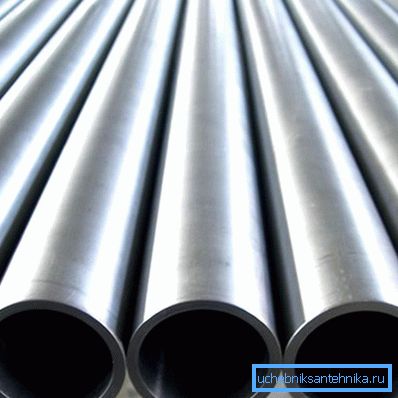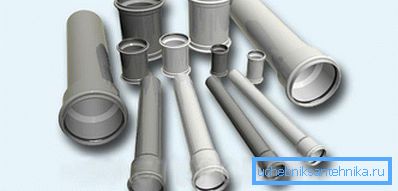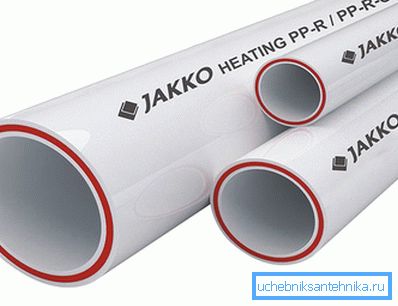What pipe to choose for water supply
Today in the market of sanitary products the choice of water pipes is wider than ever. Such plumbing products are made from different materials that have different performance characteristics. To decide which pipe to choose for water supply, you just need to understand what their features are.
Steel tubes

For many decades, no one was interested in how to choose pipes for water supply - steel pipes were almost irreplaceable. They were used both in high-rise buildings and in the private sector. They were the most popular.
Advantages:
- slightly expanding at high temperatures;
- due to sufficient mechanical strength are resistant to high pressure;
- a wide variety of compatible fittings;
- relatively cheap.
Disadvantages:
- the complexity of installation work, which in addition to professional skills require a large number of special tools, including welding (gas or electric);
- susceptibility to corrosion, as a result of which rust appears, clogging pipes and measuring instruments, which leads to an unpleasant taste of water;
- propensity to overgrowth, which leads to a decrease in the diameter of the pipes and an increase in pressure;
- electrical conductivity, which carries the potential risk of electric shock due to faulty electrical wiring or electrical appliances.
Tip! Steel pipes, one might say, are a thing of the past, although at one time they had worked hard enough. Today, such plumbing products are used only to replace local sections of the steel pipeline.
Galvanized

Such products are covered with a layer of zinc on both sides, which allows to increase the durability of pipes.
Tip! When welding, zinc emits harmful vapors, when hit into the weld, cracks occur, therefore zinc needs to be cleaned during welding, and after welding to paint the joint, as a violation of galvanizing at welding sites will lead to corrosion in the future.
Advantages:
- not subject to overgrowing from the inside;
- maintain high pressure, differ in sufficient mechanical durability;
- high corrosion resistance;
- large selection of fittings.
Disadvantages:
- the complexity of the installation work;
- the appearance of local corrosion in the connecting places;
- electrical conductivity;
- high price.
Tip! Galvanized pipes are installed today under certain circumstances, not allowing the use of modern pipes. Their acquisition and installation require significant financial costs.
Stainless steel

Stainless steel tubes are designed for various applications. They are used both inside the building and outside. They differ in that they are not susceptible to oxidation.
Advantages:
- high corrosion resistance;
- resistance to high pressure;
- well maintain high temperature;
- Do not degrade water quality.
Disadvantage:
- the highest cost among all types of pipes.
Stainless steel pipes are least in demand because of the high cost, despite the above-mentioned advantages in operation. Otherwise, such products have the same characteristics as steel.
Copper

Such pipes for water supply are designed for 100 years of service, as they are quite resistant and reliable. The advantages are greater than the disadvantages.
Advantages:
- durable;
- do not corrode;
- well maintain high pressure;
- hard to deform;
- do not expand when the temperature drops;
- bactericidal;
- spectacular appearance.
Disadvantages:
- small selection of pipes and fittings;
- during installation, a special soldering tool is needed;
- due to thin walls, mechanical strength is average;
- high price.
Copper pipes because of the high cost are less in demand than others. Although they have many advantages, nowadays pipes with such characteristics can be purchased much cheaper.
Metal pipes

Metal pipes in their time replaced the steel. They consist of five layers: two plastic, one aluminum and two adhesive, connecting the other materials. Such products are quite popular, but over time, some shortcomings emerged.
Tip! The collet fittings, which are fixed by means of sealing rings and tightened with a wrench, must always be accessed, because over time at the junction due to the lumen caused by the deformation due to heating, a leak appears.
Advantages:
- do not rust;
- great flexibility;
- the outer layer of the pipe is a dielectric;
- easy to install;
- large selection of fittings.
Disadvantages:
- poorly withstand the temperature drop - fittings need to be tightened from time to time;
- the pipe from shaped parts easily pulled out.
Tip! Metal pipes due to the possible transmission of water after a certain amount of time after installation is better not to use for a multi-storey building, but to give it is the best option.
Polyvinyl chloride

To date, despite the affordability of these sanitary products, they have been installed less and less because of the release of toxic substances into drinking water.
Advantages:
- lowest comparative cost;
- do not rust.
Disadvantages:
- unstable in operation;
- not resistant to fire;
- poison the water.
Tip! Apply PVC pipes and risk their health, of course, not worth it. You can use them only for technical purposes.
Polypropylene pipes

The situation has changed with the advent of polypropylene pipes on the market. Today it is the best pipe products, although the installation will require special equipment.
Advantages:
- do not rust;
- with a special soldering iron installed quickly and easily;
- joints are formed tight and reliable;
- strong;
- large selection of fittings that are neatly mounted.
Disadvantage:
- non-separable connections, which leads to some difficulties.
Polypropylene pipes are guaranteed for 50 years, suitable for operation at temperatures up to 100? С, they do not heat well. These pipes are worthy of the attention of consumers.
Pipe selection should be made taking into account future operating conditions.